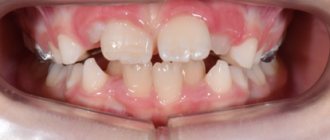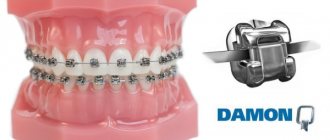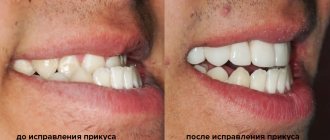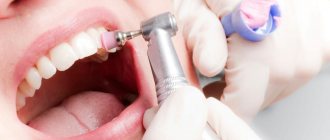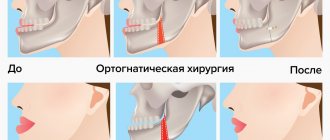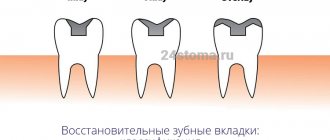Orthognathic surgery is a branch of dentistry that involves performing operations affecting the maxillofacial area. These operations on the jaw are performed by orthodontists for various malocclusions, such as underdevelopment or hyperdevelopment of the jaw, deep bite, jaw asymmetry, etc. The operations are performed by a maxillofacial surgeon in order to harmonize facial features and correct the bite while maintaining the functionality of the dentition.
When is surgery needed for bite problems?
Specialists resort to surgical intervention when conventional orthodontic treatment methods have failed.
- Wearing permanent braces.
- Treatment with aligners.
- Installation of trainers (the method is suitable for children).
- Installation of veneers (used in mild cases of malocclusion).
- Laser bite correction.
Braces or removable aligners (teeth aligners) in most cases cope with the problem. However, with significant skeletal deformations, which are expressed in the disproportionate size of the jaws, their improper closure, and deformation of the chin, these methods are powerless.
Complex bite pathologies, for example significant closure defects, cannot be treated by wearing orthodontic structures for a long time. Orthodontists do not always take this fact into account. Meanwhile, focusing only on orthodontic treatment can have significant negative consequences for the patient: tooth dislocations or pathologies of the temporomandibular joint are quite possible in this case. And they bring with them completely different problems: pain in the head and back, disorders of the gastrointestinal tract and other diseases that at first glance are difficult to associate with malocclusion pathologies.
Preparation
Before surgical intervention, a set of general preparatory measures is indicated:
- Bringing the oral cavity back to normal – eliminating plaque and calculus, eliminating caries manifestations. Amputation of the root part of organs and removal of decayed teeth.
- Leveling manipulations are a long period and involve the use of braces. After the course of treatment, the specialist, based on the results obtained, plans to correct the bite through surgery.
- Computer preparation - using modern programs, they plan a treatment regimen aimed at correcting the defect and calculate the expected result.
This is possible using 3D technologies that project a panoramic image. Based on the results of such forecasting, a template layout of the future face is drawn up.
Before the procedure itself, you must adhere to certain requirements:
- 7-8 hours before the expected start of the manipulation, do not eat or drink water;
- give up alcohol and smoking one day before;
- If you have any viral or inflammatory diseases or general malaise, immediately inform your doctor and reschedule the procedure.
Orthognathic surgery: what is it?
This is a surgical correction of the bite. During the operation, not only the bite is corrected, but also externally noticeable facial asymmetry: the surgeon shortens or lengthens the jaw, corrects its location, and changes the size of the chin. At the same time, along with the bone structure, soft tissues are also transformed. Therefore, a person’s appearance changes for the better.
When orthognathic surgery is contraindicated
Surgeons will not undertake such an operation if the jaws have not yet formed - in adolescents and children. We also highlight such contraindications as:
- cardiovascular diseases;
- problems with blood clotting;
- the presence of precancerous and cancerous diseases;
- diseases of the endocrine or skeletal system;
- diabetes in some stages;
- disorders associated with mental state.
Specialists will most likely refuse those patients who think that this operation can improve their appearance, even without problems with their bite. With all the possibilities of orthognathic surgery to rejuvenate the patient and improve his appearance, it primarily solves serious problems with bite and should not be perceived as a beauty procedure.
Advantages
The main advantages of the operation as a method of correcting malocclusions:
- Improving the quality of life, confidence in one’s own attractiveness .
After this method of correction, the patient’s self-esteem increases, psychological complexes associated with personal failure and low self-esteem from a not very presentable appearance, in particular the oral cavity, are eliminated. - The time period of therapy is several times shorter than treatment with the same results, which involves partial amputation of organs.
- Formation of the correct lip position, restoration of the correct profile shape.
- With rare exceptions, this procedure involves complete preservation of healthy organs.
- Ease of maintaining the effectiveness of the treatment.
When surgically moving a jaw fragment to a given position, the organs do not try to repeat the trajectory of the jaw. On the contrary, they maintain their original position. In addition, the teeth are trying their best to come back. This effect is achieved only by wearing mouth guards for a long time. - Minimum retention period.
What is tooth enamel hypoplasia and what method can be used to eliminate the pathology?
Let's talk here about methods for correcting an open bite.
At this address https://orto-info.ru/sistemyi-vyiravnivaniya-zubov/breketyi/po-tipu-materiala/keramicheskie/clarity.html you will find a detailed description of the design of Clarity braces.
Can complications occur after orthognathic surgery?
The result of this surgical intervention is completely predictable, so complications after surgery in most cases should not occur. There may be temporary numbness of the lips. However, in the postoperative period this is acceptable and even helps the patient avoid pain. When the previous sensitivity of the lips returns, there is no more pain.
You can insure yourself against the negative consequences of surgery if you seek help from reliable specialists.
Indications
The main indications for the operation are:
- pronounced jaw disproportions of an anatomical nature in combination with pathologies of the structure of the dentition;
- a significant violation of the relationship of the jaw fragments relative to each other, excessive development, or, on the contrary, physical underdevelopment of one of them, the inability to fully close the organs or lips (popularly this phenomenon is called the “bird face”). It is distinguished by a large lower jaw;
- a consequence of incorrectly performed surgical treatment of congenital facial abnormalities.
Do I need to prepare for orthognathic surgery?
The preparatory period can last more than one week. As mentioned above, orthognathic surgery is completely predictable. Therefore, at the first stage, the specialist decides what results should be after treatment:
✔
determines the necessary future parameters;
✔
finds the maximum possible number of closures between opposing teeth;
✔
monitors how the results of the operation will affect the patient’s appearance.
In most cases, when preparing for surgery, surgeons use special 3D modeling tools for the result. Thanks to the software, a template is obtained and the paths that will lead to the expected effect of orthognathic treatment are found.
Then orthodontic treatment with braces or aligners begins. This can take from several months to a year and a half. Once the dentition is aligned, orthognathic surgery can begin.
Orthognathic intervention takes 4-6 hours. Then the patient remains in the clinic for another 3-4 days under the supervision of the attending physician. Afterwards you can return home, and after 3 weeks you can go back to work.
Diagnostics
The main goal of any diagnosis is to identify the cause of the problem. And make a diagnosis. Likewise, the diagnosis of distal occlusion is designed to identify the cause of closure in the second class. In order to separate the flies from the cutlets during treatment, so to speak. That is, dental causes of closure are in the second class from non-dental (maxillary, skeletal).
The main diagnostic methods are:
- Analysis of TRG (teleradiogram) of the skull in a lateral projection. It allows you to clearly determine all the skeletal (jaw) nuances of the problem. Both with the position of the jaws and with their sizes.
- Analysis of plaster models of jaws (for this, casts are taken). It allows you to clarify the “dental” nuances: the size of the teeth, the length and width of the dentition, the features of the relationship (including closure) of the upper and lower teeth
Analysis of TRG (teleradiogram) of the skull in a lateral projection.
Analysis of plaster models of jaws.
It is not recommended to fall below this diagnostic “bar”. Below - just by eye. But this, as we understand, is not the best option.
Diagnostics is the first and key step in the treatment of distal occlusion. Do you want to know why it’s impossible to do without diagnostics?
How is surgical correction of bite performed?
There are 3 main types of orthognathic operations:
- maxillary osteotomy - the surgeon makes bone cuts in the mouth above the teeth and below the eye sockets to realign the upper jaw, including the palate and upper row of teeth. The jaw is fixed using a special splint, which will securely fix it in the correct position in relation to the soft tissues,
- osteotomy of the lower jaw - the doctor makes bone incisions behind the molars along the jaw downwards and, using a titanium plate, moves the lower jaw to a new place,
- Genioplasty is necessary when aligning the midline of the patient’s face, which runs between the two upper front incisors. With this method, the surgeon cuts off the chin part of the lower jaw and moves it to the correct position.
They do not leave scars on the face, because... performed inside the oral cavity. They are performed after 18 years of age, when jaw growth is completed, only under general anesthesia and for 1-6 hours.
Contraindications
The operation is not indicated for everyone. This method of treating bite pathologies should be abandoned in the following cases:
- age limit is less than 18 years;
- dentally unprepared organ fragments;
- general contraindications – dysfunction of the circulatory system, heart and vascular failure;
- diabetes;
- the presence of infections and inflammatory diseases of the oral cavity until their complete elimination;
- oncological diagnoses.
What to do in the postoperative period
In addition to following all the instructions of the attending physician, you need to pay attention to several important points.
- You need to apply ice to the jaw area and apply ointment or gel for swelling.
- Strictly observe daily routine and hygiene: get up, walk around, do not smoke, eat.
- Avoid heavy objects, do not bend over, avoid sudden movements.
- Do not hesitate to seek help if there is any discomfort.
The second most popular question concerns nutrition during the postoperative period. Contrary to expectations, the straw does not always help. According to reviews from people who have undergone this operation, it is better to use a small spoon. The only difficulty with eating usually is that it takes longer. In the hospital, during the postoperative period, patients are prescribed a gentle diet, in which dishes are served pureed.
Immediately after returning home, you can choose your usual menu, guided by your preferences. However, at first, the food should still be pureed. If necessary, you can consult a gastroenterologist.
What is the cost of orthognathic surgery?
An accurate calculation of the cost of surgical intervention can only be done individually after consultation with an orthodontist and a surgeon in the clinic of your choice. Plus, you will always additionally need to take a panoramic image or computed tomography of the maxillofacial region, condylography. In addition, correcting the bite may require the participation of related specialists.
When searching for a suitable dentist, pay attention to the clinic’s special offers: in some cases, you may be offered to pay for services in installments or in parts.

